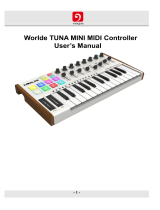
4
Control Edit Mode ..................................................................................................................................... 31
Selecting Controls ................................................................................................................................. 31
Editing Control Parameters .................................................................................................................... 31
Available Control Parameters ................................................................................................................. 32
Learn Mode ........................................................................................................................................... 35
MIDI Mode ................................................................................................................................................ 36
Selecting Controls ................................................................................................................................. 36
Adjusting Controls ................................................................................................................................. 36
MIDI Edit Mode ......................................................................................................................................... 37
Selecting Controls ................................................................................................................................. 37
Editing Control Parameters .................................................................................................................... 37
Available Control Parameters ................................................................................................................. 38
Multi Mode ................................................................................................................................................ 43
About Multis .......................................................................................................................................... 43
Creating and Editing Multis .................................................................................................................... 43
Adjusting Multi Channels ........................................................................................................................ 45
Adjusting Bus Sends ............................................................................................................................. 45
Adjusting Inserts .................................................................................................................................... 45
Multi Edit Mode ......................................................................................................................................... 46
Editing Multi Slot Parameters ................................................................................................................. 46
Available Multi Slot Parameters .............................................................................................................. 47
Key Control Mode ..................................................................................................................................... 48
Available Key Control Parameters .......................................................................................................... 48
Timing Functions ......................................................................................................................................... 49
Overview ................................................................................................................................................... 49
Tempo ................................................................................................................................................... 49
Tap Tempo ............................................................................................................................................ 49
Time Division ......................................................................................................................................... 49
Transport Control .................................................................................................................................. 49
Arpeggiator ............................................................................................................................................... 50
Note Repeat .............................................................................................................................................. 50
Technical Specifications ................................................................................................................................. 51
Trademarks and Licenses .............................................................................................................................. 51




















